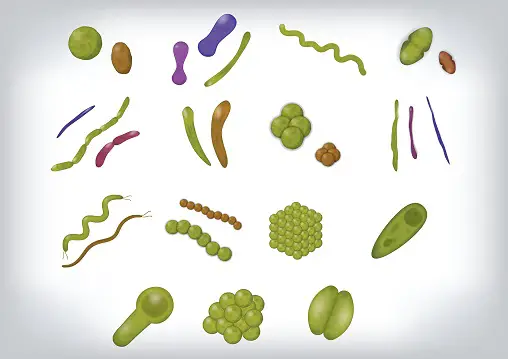Bacteria are the earliest microorganisms on the earth.
The external and internal characteristics of bacteria are a bit different from the rest of the organisms on the earth.
They are prokaryotic in nature, meaning they are the earliest forms of the cell without a nucleus.
These characters make them immortal, omnipresent, and also very versatile.
They are useful to nature, man, and life on earth, Though some can cause diseases in humans.
Unique Characteristics of Bacteria
1. No nucleus
- Unlike another eukaryotic cell, the bacterial cell is the only cell that lacks a prominent nucleus within.
- This feature has compelled scientists to consider bacteria as primitive organisms, i.e., the earliest forms of life on Earth.

2. Presence of Cell wall
Bacteria have a cell wall that is distinct from other cells having a cell wall.
The wall is made of different substances like glycoproteins, lipopolysaccharide, and lipoproteins.
3. Cell membrane
This is present immediately below the cell wall.
This has a small variation from that of plants and animal cell membranes.
In plants and animals, it is mostly a single or double layer (bilayer) of lipids.
But bacteria, especially the gram-negative ones, have an extra membrane, i.e., an outer membrane called periplasm, which lies below the cell wall but above the cell membrane.
4. Pilli
These are small and tube-like projections from the bacterial surface.
They are the organelles of sexual reproduction and are involved in exchanging genetic material as part of reproduction between two bacteria.
5. Food dependence
- All the organisms either live on their own or have other resources.
- But bacteria have different modes of food procurement.
- Some of them synthesize their food, like plants, using sunlight.
- Others derive energy from chemical sources around them (chemotrophs) — sulfur bacteria, hydrogen bacteria, iron bacteria, etc.
- Few of them are parasites that live on alive plants and animals. They cause diseases to the host in doing so.
- Many bacteria are saprophytes which means they live on dead and decaying matter.
While others are symbiotic, they live in a give-and-take relationship with other animals.
Symbiotic Ex: rhizobium in roots, E-coli in the intestine.
6. Lack of mitochondria (Respiration)
- Bacteria do not have mitochondria like typical animal and plant cells.
- However, they derive energy from aerobic respiration as the plasma membrance helps.
- In the higher cells, aerobic respiration occurs due to the glycolysis and oxidative phosphorylation pathway in the mitochondria.
- Interestingly, similar pathways also occur in the bacteria cell membrane and protoplasm to produce energy from food by aerobic respiration.
7. Reproduction
Most organisms have one or two methods of reproduction. But bacteria have many.
a. Asexual reproduction
The bacteria cell undergoes to produce two bacteria by Binary fission and also by endospores.
b) Sexual reproduction
It is also by two distinct methods like transformation, conjugation, and transduction.
In transformation, one bacteria release a naked DNA strand into the surroundings.
The other bacteria take it up and incorporate it into their genome. Transduction happens due to a virus.
Read how bacteria reproduce for more details.
8. Spore formation
- When the environmental conditions around them are harsh, the bacteria convert to a hard spore form.
- This spore is highly resistant to heat, chemicals, and drought conditions.

- When the conditions are favorable, these spores break open and release the bacteria.
9. DNA Gyrase
They also have molecular characteristics that are different from others like
- Gyrases are the enzymes involved in DNA transcription.
- They perform nick and joint functions in the DNA chains.
- They cut the strands, induce negative supercoils, and join the cut ends afterward.
- In Humans and other mammals, there is DNA topoisomerase-II instead of DNA gyrase for a similar function.
10. Ribosomes
- The protein-making machinery has a 70S ribosome of two sub-units: 50S and 30S.
- While in other animals and plants, it is an 80S ribosome consisting of two sub-units, 60S and 40S.
11. The absence of Cell organelles
Other cell organelles like mitochondria, Golgi bodies, and endoplasmic reticulum are absent in a bacterial cell.
12. Flagella presence
- Some of the bacteria are motile. Especially the bacilli type have flagella.
- These are the organs of locomotion.
- They are long filamentous organs originating from the cell membrane.
- You can learn more about flagella at bacteria classification.
- They are classified based on the number and arrangement of flagella in the cell.
13. Bacteria shape
The shape of bacteria is very characteristic of them.
It is also easy the identification of bacteria by recognition of shapes.
These bacterial structures have a specific shape like a stick (bacilli), spherical (cocci), coma (cholera bacteria), spiral (spirochete), in a bunch of isolated, etc.

14. Cosmopolitan distribution
- Bacteria are the only organisms that show cosmopolitan distribution.
- They are present in the air, water, soil, snow, etc.
- They are present in very cold (minus degree) temperature regions and also very high-temperature regions.
- They can live in an acidic environment (Helicobacter pyroli) and even an alkaline environment (iron bacteria).
15. Resistance and tolerance
- Some of the bacteria are highly resistant to adverse situations.
- Even they acquire a tolerance to harsh chemicals and drug which can destroy them.
- Hence, as per World Health Organization, irrational use of antibiotics has lead widespread resistance.
Frequently asked questions and answers
What is the Largest Size Bacteria.
Thiomargarita Magnifica Bacteria is largest size bacteria with size ranging between 750μm to 20mm.
Largest size bacteria
but how do they respire?
Hi thomas uray! Thanks for stopping by. You question has been answered in the point 6. We have updated respiration method in the bacteria there. Please check.
good website gives a lot of ideas for my science project
very helpful in making presentations
This is very good information
Good website and gives a lot of ideas too